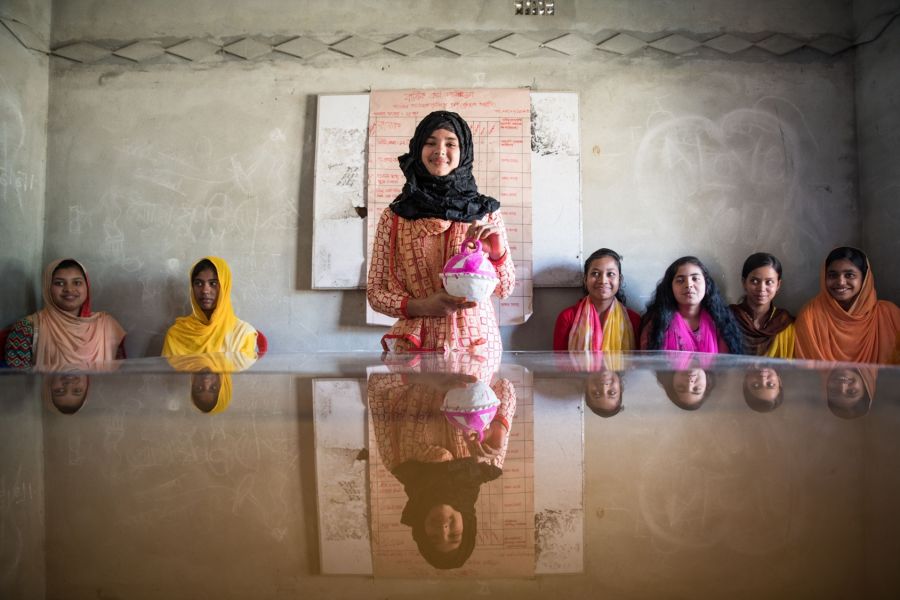
Over the past several months, the COVID-19 pandemic has been top of mind for most Canadians, drawing daily headlines and news coverage as governments across the world fight to contain its impacts.
While global attention is currently fixated on the impacts of COVID-19 infections, deaths, and the impacts of lockdowns, the pandemic has exacerbated already existing gender disparities. During COVID-19, the risks of increased malnutrition and food insecurity are significant amongst women and girls in low- and middle-income countries, with potentially long-lasting and detrimental impacts on health, wellbeing, and future global stability.*
Within a few months, COVID-19 has had significant and negative impacts on global health, nutrition, and poverty, and exacerbated inequality related to food systems, gender equality, and gender-based violence (GBV). A common experience during pandemics is that already strained food systems and income sources mean that nutritious food is less available, and women and girls are most vulnerable to eating least, last, and poorer quality. During the Ebola outbreak, the social and economic impacts disproportionately affected women, because of various overlapping socio-economic vulnerabilities and pre-existing gender inequalities, leading to increased malnutrition and poorer health outcomes.
The recently released 2020 Global Nutrition Report, although focused on equity, contained no discussion of gender dynamics whatsoever – a significant gap. But nutrition and gender equality are critically, and irrevocably, linked across nearly all aspects of global health programming.
It is well recognized that multisectoral nutrition approaches are important for addressing malnutrition and its impacts. A shift in nutrition programming is necessary in order to understand gender inequalities and the high-risk impact it has on women and girls. It is crucial that beneficiary targeting is focused on empowering women and girls as transformational change agents. This entails women and girls holding agency as well as structural power to meaningfully and sustainably close gaps in gender disparities. It also requires women and girls to actively engage in identifying and addressing barriers in the underlying socio-cultural, economic and political environments that limit their decision-making power and ownership over assets necessary for achieving optimal nutrition for themselves and their dependents. It also demands change in current systems and structures, to become more equitable and responsive to the needs of women and girls and other marginalized groups.
The impacts of malnutrition extend to educational achievement, earning potential, and economic empowerment, but this relationship extends both ways. To truly make progress on improving the nutritional status of women and girls, we need to create opportunities for food production, savings, good hygiene, and improved literacy, to name but a few interventions. We need to recognize the depth and breadth of women’s and girls’ needs, and strengthen our collaborative programming accordingly.
The Gender-Transformative Framework for Nutrition (GTFN), a conceptual model supported by research and practice, will enable improved gender analysis, design, and monitoring and evaluation of nutrition approaches and interventions for gender equality. The GTFN will unlock the potential of nutrition programmes to address gender inequalities through analysis of gender and how gendered understandings, beliefs and norms shape roles, relationships, division of labour, access, control, power, and nutrition practices within families, communities, institutions, culture, and economy.
Through a consortium of partners, led by World Vision Canada, with expertise in research, technical programming, and political will and advocacy, we are ensuring that the framework is evidence-informed, beneficial for programming, and supported by major global nutrition bodies. Over the next six months, we will develop a conceptual framework that demonstrates the key ways in which nutrition and gender equality interact and support each other; supplementary evidence and policy briefs that dive into further depth on particular sectors and components; and a toolkit of user-friendly tools for program implementers for design, monitoring and evaluation mapped to the framework (which would include the rapid assessment tool as well as other existing resources).
Once finalized, we will call on nutrition leaders, donors, and stakeholders to commit to incorporating and upholding the gender equality-driven tools in their nutrition programming.
Through the advancement of the deliverables listed above and using the vast networks and expertise of the coalition members, the GTFN Coalition will transform the narrative around nutrition programming globally, advancing gender-transformative nutrition policy and advocacy on the global stage, and empowering women and girls, both individually and collectively, to shape their rights and outcomes as they desire.
For more information and to participate in discussions on the Gender-Transformative Framework for Nutrition going forward, please sign up to our listserv here, or reach out to Caroline Marshall.
SUBSCRIBE TO RECEIVE EMAIL UPDATES
Publié:
mai 26, 2020
Auteur:
World Vision Canada
Catégories:
Partager cette publication: